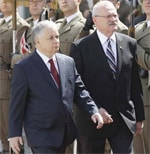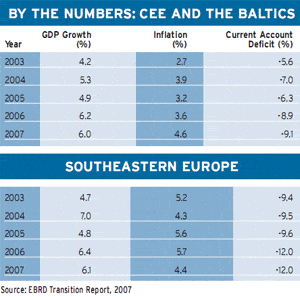They dodged the early fallout from the credit crunch, but Central and Eastern Europe’s economies are facing growing challenges.
 |
|
All change: Central and Eastern Europes economies are in transition. |
Next year Europe’s post-communist countries commemorate 20 years since the fall of the Berlin Wall. They should be in a celebratory mood. With the exception of the countries of the former Yugoslavia, most can look back on a radical transformation achieved without violence, an era when their forced 40-year separation from Western Europe was ended and living standards began a long upward climb.
With the Warsaw Pact and Comecon consigned to history, most have joined NATO, a vastly significant symbolic step for countries long terrorized by Moscow. Most have either full membership of the European Union or, in the case of former Yugoslavia and Albania, Stabilization and Association Agreements (SAAs), the first step to membership. Next January Slovakia will become the second post-communist country—after Slovenia—to join the eurozone, a remarkable achievement given that for much of the 1990s it stagnated under a succession of nasty populist governments headed by former premier Vladimir Meciar. (Slovakia’s unsung hero is his successor, Mikulás Dzurinda, whose radical reforms transformed national finances and turned the country into a magnet for foreign investors).
Although by BRIC standards these economies remain relatively small, their significance has grown fast. Poland, which over the 1990s provided big profits for EU manufacturers establishing businesses and taking advantage of its low wages, is now the fourth-biggest market for eurozone exporters after the United States, the United Kingdom and Switzerland as increasingly wealthy Poles buy more EU goods.
Another dramatic change has been in the financial sector. Most former state-owned banks are now in not only private hands but foreign ones: Some 80% of financial institutions are now owned by foreign banks, with banks in Hungary, Slovakia and the Baltic States almost entirely foreign owned. The result has been an extraordinary amount of highly beneficial integration with the West’s—and thus the world’s—financial system.
The most radical changes, however, have been in the daily lives of the people, with most enjoying a prosperity of which their parents could only dream. Living standards have soared: The Czechs, for example, have seen per capita GDP rise from $5,000 in 2000 to $23,000 today. Slovaks have enjoyed a rise from $3,800 to $18,700, while in Poland today’s per capita GDP of $15,700 compares with just $4,900 back in 2000. Even Romania, one of the region’s poorer economies, has seen its per capita income rise from $1,600 at the start of the decade to just under $10,000 in 2008. Although some of this reflects the dollar’s depreciation—its value has fallen dramatically against most east European currencies—most of the rise reflects growing national wealth.
“Prosperity has been driven forward by FDI, EU transfers and in particular the growing availability of credit, fueled by low interest rates,” says Charles Robertson, chief emerging markets economist at ING Barings, who argues that the tiny Baltic states and Slovakia have probably experienced the most dramatic reversal.
After the Crunch
The big questions now are what impact the credit crunch will have and how the economies will look next year as the region prepares to celebrate 20 years of transition. Opinions seem divided. “The region seems so far to have been fairly immune from the turbulence, although it’s a sensitive time, and things could yet go wrong,” says Judy Batt, southeast Europe analyst at the University of Birmingham, England.
 |
|
Good neighbors: Poland’s president Lech Kaczynski (left) and Slovakia’s president Ivan Gasparovic. |
Bob McKie of Independent Strategy is more pessimistic. “Across the board, growth will be lower; no country will be able to fully escape. We’re in for a tough two years,” he argues, suggesting the Baltics and southeast Europe (Romania, Bulgaria and former Yugoslavia) in particular are much more vulnerable to the crunch than either Asia or Latin America. He suggests that a combination of overvalued property markets (largely fueled by Western speculation) and local banks and their risk-averse Western owners becoming increasingly wary of lending raises the possibility of recession. This is particularly so in countries with a currency board—Bulgaria, Estonia and Latvia—where currency devaluation is not an option, but it is an issue elsewhere, too.
Erik Berglof, chief economist of the European Bank for Reconstruction and Development (EBRD), believes the region has positioned itself well to avoid the worst effects of the credit crunch. He argues that the long-term macroeconomic and institutional reforms the countries were obliged to make to prepare for EU membership have provided a firm foundation, as has the strong presence of Austrian, Scandinavian, German, Greek and French banks, which have helped make the financial sector highly trusted across the region. “So far the credit crunch has been dealt with relatively well although inflation now poses a major challenge,” he says.
So where will the crunch bite hardest? It’s too early to tell, but it would seem the prospects for Central Europe, the Baltic states and southeast Europe are all very different.
Central Europe looks best positioned to weather the storm, thanks to the fact that reforms there are most advanced (and all but finished in some cases) because it is the most closely integrated with the EU and eurozone and because energy and food take a smaller share of average incomes than elsewhere. Continuing strong export growth and a generally dynamic private sector should also reassure in the event of any fall-off in foreign direct investment. The EBRD’s Berglof is predicting 2008 growth will slow only slightly, to 4.7%, against 5.9% in 2007, although he has revised this down from last November’s prediction of 5.2%.
Slovenia and Slovakia seem at least risk of volatility thanks to, respectively, existing and pending euro membership. In early July the Slovak crown’s conversion rate was formally set at 30.126 koruna to the euro. In Poland the newish government of prime minister Donald Tusk has promised to press ahead with privatization and state finance reform, a marked improvement on its conspiracy-obsessed, dysfunctional predecessor. The Czech Republic is seen as a solid performer. ING’s Robertson expects 2008 growth at around 5%, with Poland growing by the same amount. Slovakia’s finance ministry anticipates 7.7%, down from 2007’s record 10.4%.
The biggest concerns surround Hungary. Its deeply unpopular government became a minority Socialist one after the departure of the Free Democrats from the ruling coalition earlier this year. With growing doubts about whether the government can pass its budget through parliament later this year, it looks set for continued uncertainty. Hungary recently had some good news: Against the odds, Daimler-Benz recently chose Hungary over the expected destination, Poland, for an €800 million investment. But external debt rose 45% year-on-year in the first quarter to reach a record €115.4 billion.
That said, Slovakia’s pending euro membership has put upward pressure on all the central European currencies, with investors keenly anticipating more new members. Yet Robertson believes the optimism is misplaced. “This trading seems overdone. You shouldn’t expect new central or east European euro members anytime soon,” he says.
Baltics Missing Out
Further north, the situation facing the Baltics is rather more severe. First-half figures suggest Estonia and Latvia may see their economies contract in 2008. Lithuania’s slowdown has been less severe, possibly because it does not have a currency board and thus enjoys greater flexibility. This represents a dramatic change from recent years, when double-digit growth has been the norm. Berglof predicts a bumpy landing rather than a crash, the main cause being the curbing of excessive credit, which had been fueling, among other things, a housing boom. The biggest challenge will be controlling inflation; May figures suggest this is running at 11.4% in Estonia, 12% in Lithuania and 17.9% in Latvia, the highest level in the EU.
 |
The southeast European countries can also expect to experience something of a hangover after several years of strong capital inflows and domestic credit growth; the current account deficit in Bulgaria is currently running at a startling 22% of GDP, and in Romania, 14.5%. To Robertson, the two countries resemble the Baltics in 2004-2005, with inflationary and fiscal risks rising and overheated housing markets. Although the regionally omnipresent Greek banks are still lending, he does not expect this to continue, which will mean a slowing in GDP growth.
But not yet: Dutch bank ING is still forecasting 6% growth in Bulgaria and 8% in Romania for 2008, while the EBRD predicts 5% for the region, against its earlier forecast of 6%. More of a concern is inflation, expected to rise with possibly serious social consequences given that food in this, the poorest part of Europe, can easily account for 50% of household spending.
There are some bright spots: Croatia continues to prepare for EU membership while Serbia’s new government, a counter-intuitive coalition between the reformist Democrats and the Socialists, Slobodan Milosevic’s old party, has put EU accession and continued economic reform at the top of its priority list, with the arrest of former Bosnian Serb leader Radovan Karadzic seen as proof of its desire to break with the past. However, the mood regarding some of the smaller Balkan states is less sanguine, with Bosnia and Herzegovina and Macedonia seen as becoming increasingly dysfunctional.
Berglof is concerned that, throughout southeast Europe, enlargement fatigue within the EU may lead prospective members to ease up when in fact deeper reforms are needed. Corruption, lack of transparency, poor corporate governance and incompetent judiciaries remain the Achilles’ heel of southeastern Europe and key priorities for all its governments.
So with all three of the post-communist regions expected to experience varying degrees of slowdown coupled with rising inflation, what should be the response—aside from following pragmatic, confidence-sustaining but flexible economic policies? Over the long term, investment in infrastructure must be boosted: Poland, for all its advantages, still has just 350 miles of freeway, making travel between the main cities akin to an endurance test.
Investment in higher education, training and R&D; is also vital. Berglof says companies and banks continue to encounter shortages of top, senior-level personnel. And with growing evidence that rising wages and inflexible labor markets are undermining long-term competitiveness, creating more open and liquid labor markets remains key to ensuring continued capital flows to the region.
Analysts believe one of the biggest favors the post-communist countries could do for themselves is boost regional integration. In many ways, the startling lack of it is a communist legacy: Before 1989 economic policy was autarkic, with Moscow in many cases the only trade partner. Yet transition has reinforced the tendency of the southeast European countries in particular to act as if their neighbors did not exist. If one consequence of the credit crunch is to make them realize that closer trade and financial links will make them stronger and help boost growth and the private sector, the next 20 years could be as exciting as the past 20.
Justin Keay



